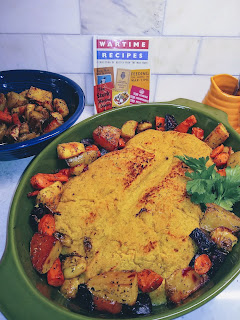Wartime Recipes Cookbook
Can you guess what the meal in the picture is? No, it’s not roadkill, although it does resemble something that’s been run over by a semitruck. What we have here is a delicious Mock Duck. It was made with red lentils and rice. I found this recipe in the Wartime Recipes cookbook.
After reading numerous historical fictions about WWII, I really wanted to find a cookbook that offers different versions of coffee substitutes that are mentioned here and there in books: coffee made from acorns (The Paris Architect by Charles Belfoure); coffee made from carrots, acorns, parsnips (The Girl from the Channel Islands by Jenny Lecoat); or chicory coffee (The Rose Code from Kate Quinn). Sadly, this cookbook did not have any such recipe. It did, however, offer other recipes from a time when food was scarce, especially coffee, sugar, eggs, butter, and other items.
The Mock Duck recipe caught my eye, because, it too, was mentioned in The Rose Code, so I decided to give it a try. First lesson: these are grandma-style recipes. You know, when grandma says just add a pinch of this and a dash of that, cook, bake and you’re done. These are not recipes that take your hand and lead you through the process like a child. You won’t be told every little detail. Just imagine grandma rolling her eyes at you with a look that says “how you can make it through the day all by yourself?” Then roll your sleeves up and get to work.
The Mock Duck recipe listed the ingredients and some basic steps, but I had no idea how long to cook the lentils on the stove, how long to bake it in the oven, or what temperature to bake it on. With grandma looking down from heaven above, I figured out that the lentils were done when they became the texture of playdough after about 1 hour and 15 minutes. I took the pot off the stove and as instructed placed the lentil-dough on a greased baking dish and shaped it to look “as much as a duck as possible.” Not as easy as it sounds. Any previous visions I may have had at trying my hand at sculpting were quickly put to rest. Then I placed my deformed little "Daffy" in the oven for another half an hour or so guessing the temperature to be 350*. The recipe instructions say to baste the “duck” so it doesn’t dry out, but of course, they don’t say with what, so I chose white wine. Not sure grandma approved. In the end my fully “roasted duck” was more like a refried bean pie than any poultry I’ve had before, BUT it was surprisingly tasty!
I wouldn’t mind making it again, but it sure would be nice to hear from someone, anyone else, who’s made it to give me clues and advise me if I came anywhere close to what it was supposed to be.
I will try more recipes from this book in the future, but I can pretty much guarantee that I will skip the Savory Tripe Casserole and Roasted Sheep Hearts!
Happy Reading,
Happy Eating
Annette





Comments